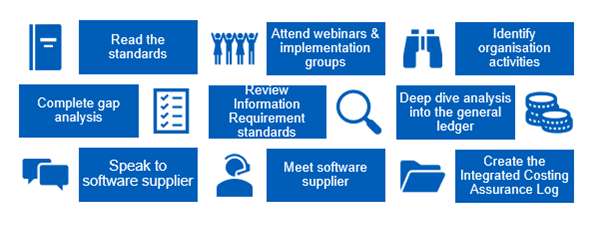The costing process enables providers of NHS services to cost services and submit invaluable patient-level costing data for the National Cost Collection.
This quick guide provides an overview and summary of the process and what is involved in its implementation.
It is not a substitute for the full Approved Costing Guidance of costing standards and the National Cost Collection guidance.
If you are a costing practitioner, we recommend you work systematically through the standards guidance applicable to your sector and your services as you implement the costing standards.
Begin by reading our introduction to the Approved Costing Guidance and Costing principles. The Costing glossary will help you understand the terminology and concepts used in the standards. Supporting information and resources are on our FutureNHS workspace.
Overview
The costing process is based on…
|
It starts with good source information…
|
You will need…
|
| Get your costs in the right starting position with the right starting label…
Discuss with your finance colleagues:
|
Summary
- The aim of the costing process is to keep an accurate record of Who did What to Whom for What amount.
2. We use resources to cover the ‘who’ part, categorising costs based on staff and the resources they use. Resources also cover non-pay items.
3. We use activities to cover the ‘what’ part and allocate resources to them so that we have costed activities that describe the things done for patients.
4. Activities can be matched to patients or services (for example when performed for other healthcare providers or which incident attended by ambulance), covering the ‘whom’ part.
5. The ‘what amount’ part should be covered by allocating costs through all the way from resources to patients (or services) and will be reported as a cost for each resource-activity combination.
6. Various software solutions can support this process. We do not prescribe the software solutions: you should contract with a software supplier that suits your organisation’s needs. You should also refer them to our minimum software requirements.
7. There are five costing process standards:
- CP1: Ensuring the correct cost quantum: set outs how the general ledger is used for costing and highlights the areas that require review to support accurate costing.
- CP2: Clearly identifying costs: ensures costs are in the correct starting position and correctly labelled for costing.
- CP3: Allocating costs to activities: ensures the correct quantum of costs is allocated to the correct activity using the most appropriate costing allocation method.
- CP4: Matching costed activities to patients: ensures consistency in assigning costed activities to the correct patient event.
- CP5: Reconciliation: sets out the process for reconciling costs and income to organisation accounts and reconciling the activity counts reported by the organisation.
Implementing the costing process


